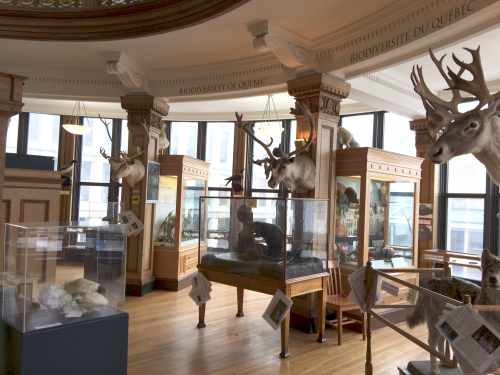
Four Pillars of the Redpath Museum: Biodiversity
 BIODIVERSITY
BIODIVERSITY
Biodiversity—the variety of life—is another important corner-stone of the Redpath Museum collection. This collection represents multiple branches of zoological life including both vertebrates and invertebrates, and extant and extinct species.
HISTORY
The Redpath Museum’s biodiversity collection dates back to the mid-nineteenth century. One of the Museum’s most prominent biodiversity donors was Duncan M. Hodgson, a Montreal philanthropist who lead many expeditions to Africa. In 1930, Hodgson returned from his expedition to the Congo with 7,000 entomological (insect) specimens, 400 ornithological (bird) specimens and a collection of African mammals including an okapi, bongo antelope, chimpanzees and hogs. One of the most well-loved specimens he returned with was a gorilla who he named George. George, whose home is on the staircase going up to the third floor, was used by the Museum to increase morale during the Second World War.
ON DISPLAY
The top shelf contains invertebrate specimens: animals that do not have a backbone. Scientists estimate that the vast majority of animal species are invertebrates; some even estimate up to 97%. Some invertebrate groups that are represented here include Porifora (the sponge), Cnidaria (the jellyfish), Arthropoda (the crab), and Echinodermata (the starfish).
The second shelf contains fish and amphibian specimens. Two major groups of fish are represented on the left: fish with a cartilage skeleton, like this ray, and fish with a bone skeleton, like this lionfish. Tetrapod’s—vertebrate animals with four limbs—evolved from a group of lobed finned fishes. The earliest tetrapods to evolve were amphibians. Amphibians are interesting because their young undergo metamorphosis from an aquatic larva with gills to a semi-aquatic adult with lungs. Out of the three main groups of Amphibians—frogs/toads, salamanders/newts, and caecilians—two are shown here. Can you guess which two?
The third shelf contains reptile and bird specimens. Did you know that reptiles are very closely related to birds? Some species of reptiles are even more closely related to birds than they are to other reptiles! On display we have a turtle and snake, though crocodiles and lizards are also well-known types of reptiles. The birds on display are all local to Quebec; have you seen any of them before?
The final shelf contains mammal specimens. Mammals are unique to the animal world because they have hair, special middle ear bones, and nurse their young with milk. Some mammals are carnivores and have sharp pointy teeth like you can see with the wolf and lynx skull, while other mammals are omnivores, like the red squirrel.
The Redpath Museum contains over 70,000 catalogued specimens in their biodiversity collection, including a world-renowned shell collection, and the world’s largest collection of seahorses. Want to learn more about our biodiversity collection? Please visit the second floor of the museum! At the back of the Dawson gallery we have our Quebec Biodiversity exhibit, and along the staircase between the second and third floors of the museum we have our African Mammal exhibit.